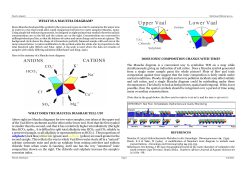
Chemical Bonding 4.1 The Octet Rule
www.apchemsolutions.com The Octet Rule Elements tend to gain, lose, or share electrons to acquire a full octet. es Chemical Bonding 4.1 • In n = 1 a full octet consists of 2 electrons. • There is only one 1s orbital. • From n = 2 to n = 7, a full octet consists of 8 electrons. • A full s-orbital and a full p subshell. The Formation of Ions ts Electron Configurations of Ions Non-metals gain electrons to become negatively charged anions. Na Incomplete Octet ud en Metals lose electrons to become positively charged cations. 'L ec tu re N ot Octet Rule Ionic Bonding Lattice Energy Covalent Bonding St Non-Metals + + + 1s2 2s2 2p6 3s1 = [Ne] 3s1 1s2 2s2 2p6 = [Ne] C op y of Metals Na+ Complete Octet Lost the electron from n = 3 to acquire a full octet pl e Electron Configurations of Ions Sa m Cl Incomplete Octet ClComplete Octet Gained an electron in n = 3 to acquire a full octet + + 1s2 2s2 2p6 3s2 3p5 = [Ne] 3s2 3p5 1s2 2s2 2p6 3s2 3p6 = [Ne] 3s2 3p6 = [Ar] The charges on ions are usually related to the group they’re in. Group 1A Æ +1 (H can also be –1) Group 2A Æ +2 d-block Æ +1 to +4 (it’s hard to predict) Group 3A Æ +3 (Tl can also be +1) Group 4A Æ +4 (Sn and Pb can also be +2) Group 5A Æ -3 non-metals, +3 and +5 metals Group 6A Æ -2 Group 7A Æ -1 © 2009, 2008 AP Chem Solutions. All rights reserved. 1 www.apchemsolutions.com es • These elements lose electrons from their highest s-sublevel first before losing from their d-sublevel. Ionic Compounds are created when a metallic cation forms an electrostatic bond with a non-metal anion. • Ex) Iron may form 2 types of ions. • Fe [Ar] 4s2 3d6 • Fe2+ [Ar] 3d6 Æ Lost electrons from 4s • Fe3+ [Ar] 3d5 Æ Lost electrons from 4s and one in 3d. Non-Metals 'L ec tu re Metals N ot d-block cations ud en 1) Metals transfer electrons to non-metals, and the two form bonds due to the electrostatic attractions between them. ts Ionic Bonding Ionic Bonding Defined or Na + Cl Æ Na+ + [ Cl ]- C op y of St 2) Cations (metal ions) and anions (non-metal ions) form electrostatic bonds based on opposite charges. • Cations and anions may be polyatomic Lattice Energy pl e Lattice Energy m • The energy required to break one mole of a solid ionic compound into its individual gaseous ions. Sa • This requires a lot of energy as ionic bonds are very strong. • Very Endothermic NaCl(s)Æ Na+(g) + Cl-(g) ΔHlattice = +788 kJ/mol Na+(g) + Cl-(g) Æ NaCl(s) ΔH = -788 kJ/mol • Conversely, putting a lattice together is Very Exothermic © 2009, 2008 AP Chem Solutions. All rights reserved. 2 www.apchemsolutions.com Factors Affecting Lattice Energy Ex) Trends in Lattice Energy d E= _ KQ1Q2 d 1) LiF K = 8.99 x 109 Jm/C2 2) MgCl2 MgO 3) NaF MgI2 re d = distance between ionic centers LiI N ot + es Ex) Which compound from each set has the highest melting temperature? Why? Electrostatic Equation Derived from Coulomb’s Law 'L ec tu Q = the charge of a single ion Properties of Ionic Solids Covalent Bonds ts • High Lattice Energy ud en – High melting point • Cleaves along planes – Brittle 3D structure – Ions line up in a repetitive pattern. • Ions St – Most are soluble in polar solvents. – Conduct electricity when molten or dissolved in a polar solvent One atom shares electrons with another atom so that both acquire full octets. Occurs between two non-metals C op y of • The higher the concentration of ions in a solution, the higher the electrical conductivity. Electronegativity and Bond Polarity m pl e Types of Bonds Sa Covalent Bond 0 0.5 F Polar Covalent Bond F H F Na+ F- Ionic Bond 1.9 3.5 Covalent Bond Polar Covalent Bond Ionic Electronegativity Difference © 2009, 2008 AP Chem Solutions. All rights reserved. 3 www.apchemsolutions.com Determining Bond Type H-H H-Br 2.1 2.1 2.8 N ot 2.1 es Determining Bond Type Electronegativity difference = 0.7 'L ec tu re Electronegativity difference = 0.0 ud en O-C-O 3.5 Determining Bond Type ts Determining Bond Type St 2.5 1.0 4.0 Electronegativity difference = 3.0 C op y of Electronegativity difference = 1.0 LiF pl e Molecular Compounds Defined m Molecules: Sa • Two or more non-metals bonded together to form a compound. • Bonds between atoms are covalent or polar covalent. © 2009, 2008 AP Chem Solutions. All rights reserved. 4
© Copyright 2025





















